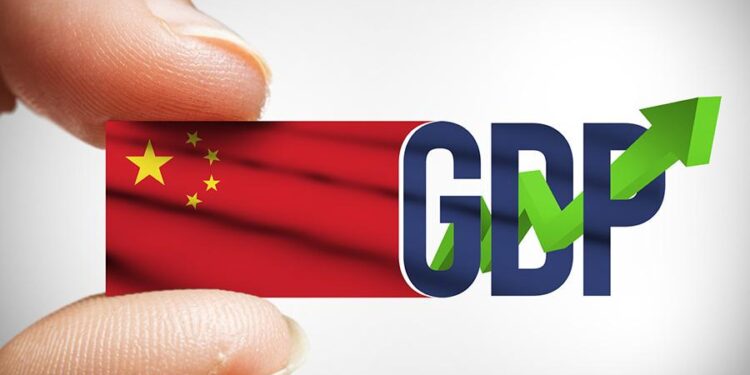China’s economy has defied recent uncertainties, posting stronger-than-expected growth despite rising concerns over trade tensions with the United States. As tariffs imposed under the Trump administration threaten to disrupt global supply chains, the latest data reveals resilience in China’s GDP, highlighting the nation’s capacity to withstand external pressures. This unexpected economic performance comes at a critical juncture, raising questions about the future trajectory of Sino-American trade relations and their broader impact on the global economy.
China Surpasses Growth Forecasts Amid Rising Trade Tensions
Despite increasing concerns about the escalation of U.S. tariffs, China’s latest economic data reveals a robust expansion that has outpaced analyst predictions. The nation’s GDP growth stood firm at 6.8% in the last quarter, demonstrating resilience amid global uncertainty. Key sectors such as manufacturing and services showed notable strength, with domestic consumption acting as a crucial driver to buffer against export fluctuations caused by the looming trade restrictions. Government stimulus measures and policy support have also played a vital role, signaling Beijing’s commitment to sustaining growth during these challenging times.
The complexities of the current trade environment have led companies to adapt swiftly. Notable trends include:
- Increased diversification of supply chains to mitigate tariff impacts
- Stronger focus on technological innovation and high-value industries
- Expansion of domestic markets to reduce reliance on external demand
Below is a quick snapshot of China’s economic performance indicators from the recent quarter:
| Indicator | Value | Change YoY |
|---|---|---|
| GDP Growth | 6.8% | +0.2% |
| Industrial Output | 7.2% | +0.5% |
| Retail Sales | 9.5% | +1.3% |
| Fixed Asset Investment | 5.7% | +0.8% |
Analyzing Sectoral Drivers Behind Unexpected Economic Resilience
China’s unexpected economic resilience amid looming Trump administration tariffs has been largely attributed to a robust performance across several key sectors. Manufacturing maintained its strength thanks to rapid technological adoption and diversified supply chains, enabling factories to bypass tariff impacts in certain export segments. Meanwhile, the service sector showed significant expansion, driven by increasing domestic consumption and e-commerce growth, which insulated the economy from external shocks. Agricultural output also defied expectations, with innovative farming techniques and government subsidies stabilizing rural incomes and demand.
A closer look at the sectoral contributions paints a more detailed picture of this resilience. Below is an overview showcasing the percentage growth contributions of major sectors in Q1 2019:
| Sector | Growth Contribution (%) | Key Drivers |
|---|---|---|
| Manufacturing | 35 | Automation, export diversification |
| Services | 40 | Domestic demand, e-commerce boom |
| Agriculture | 10 | Tech adoption, subsidies |
| Construction | 15 | Urbanization, infrastructure projects |
- Manufacturing resilience is partially attributed to companies shifting focus towards advanced machinery and high-end electronics.
- Service sector growth underscores China’s strategic pivot towards a consumption-driven economy.
- Agricultural stability reflects government intervention and modernization of rural economies.
Policy Recommendations to Sustain Momentum Amid Tariff Uncertainties
To navigate the unpredictability surrounding tariffs, Chinese policymakers should prioritize economic diversification and strengthen domestic consumption. Reducing reliance on export-driven growth allows for resilience against external shocks such as trade restrictions. Encouraging innovation in high-tech industries and expanding the service sector can provide fresh momentum, while targeted fiscal stimulus in infrastructure and green technology will create new jobs and maintain investor confidence.
Furthermore, enhancing trade partnerships beyond traditional markets is essential. Expanding access to emerging economies and deepening involvement in regional trade agreements can offset tariff pressures from the US. Transparent communication and regulatory clarity will reassure businesses and foreign investors, mitigating market volatility. Below is a concise overview of recommended policy focus areas:
| Policy Focus | Objective | Expected Impact |
|---|---|---|
| Domestic Consumption | Stimulate spending power | Boost internal demand |
| Industrial Innovation | Develop tech sectors | Increase productivity |
| Trade Diversification | Expand export markets | Reduce tariff risks |
| Regulatory Reform | Enhance transparency | Improve investor confidence |
Concluding Remarks
As China’s economy continues to outpace forecasts despite mounting trade tensions and the threat of additional tariffs from the United States, the global financial landscape remains closely attuned to the developments. While the robust GDP growth signals resilience, analysts caution that prolonged uncertainty surrounding trade policies could pose challenges ahead. The coming months will be pivotal in determining whether China can sustain this momentum amid escalating geopolitical pressures.































